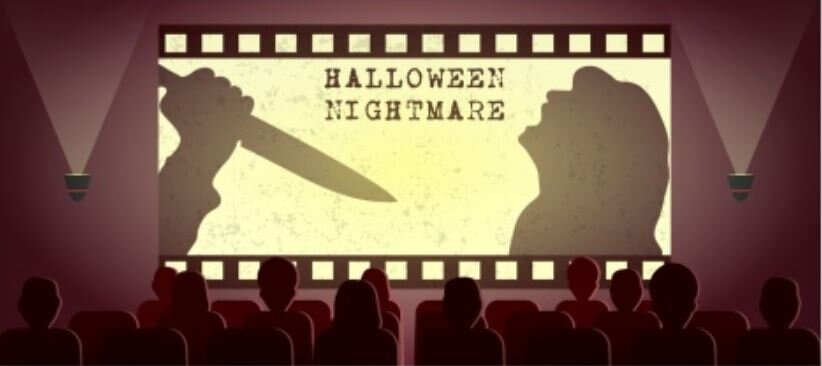Unproblematic Movies to Watch This Spooky Season
graphic courtesy of freepik.com
Do you like scary movies? As much as we hate to admit it, some of our favorite horror flicks follow the same, problematic trope. Take Halloween (1978) for example. Every girl who shows her breasts gets killed off. Or Wes Craven’s Nightmare on Elm Street (1984), where Freddy Kreuger slaughters the first victim right after she has sex with her boyfriend. Jason in Friday the 13th (1980) murders couples caught “doing it” at summer camp. See the pattern?
We often see this “Final Girl” trope, where the last victim is always the bookish, goody-two-shoes girl who never drinks or has sex, unlike those victims before her. Aside from blatant sexism, another issue in scary movies is the exploitation of mental illness. We see it today, especially in popular films like Split (2017) and in TV shows like American Horror Story, which falsely equate mental illness with psychosis and glorify depression.
While we may all be guilty of indulging in these controversial classics, we have been blessed with a few exceptions. The year 1996 saw the release of two iconic, unproblematic horror flicks—Scream and The Craft.
You probably know Wes Craven’s Scream (1996), even if just through the modern TV show adaptation. Or at least, you think you know the movie. Although it is one of the better- known horror flicks, starring the famous Ghostface killer, the feminist value of this film is overlooked.
Different characters throughout the film poke fun at the obvious slut-shaming in famous scary movies. The character Randy emerges as this film’s unexpected Wise One. His role is more than just as the side-character friend or comic relief—he’s probably one of the most self-aware horror film characters of all time. He says Jamie Lee Curtis’s characters always survive until the end of their movies, such as Halloween and Prom Night because she “never shows her breasts.” She always played the virgin, which was the “only way” she could outsmart the killer in the end.
Scream follows protagonist Sidney Prescott, played by actress Neve Campbell. Her boyfriend Billy, played by Skeet Ulrich (AKA Jughead Jones’s dad on Riverdale), is a horror-film fanatic with crippling Mommy issues who likes to sneak through Sidney’s window at night. Spoiler alert—he’s the killer.
Maybe you’ve already seen the popular gif where he turns around, all bloody-faced and menacing, before quoting the line from Alfred Hitchcock’s Psycho (1960), “We all go a little mad sometimes.” But the real reason we love Billy—the character, I mean—is because he embodies everything wrong with misogynistic horror film plots. After Billy reveals himself as the killer, we learn that he’s been targeting Sidney all along. Why? Sidney’s mother slept with Billy’s father, which is why his mother walked out on the family. Billy also admits to killing Sidney’s mother, which happened one year before the film takes place. So, here’s the breakdown.
First, Billy never blames his father for cheating on his mother. Instead, he targets Sidney’s “slut” mother, as he calls her. Next, he doesn’t reveal himself as the killer until Sidney finally agrees to sleep with him—that’s all part of his “game,” as he says, which follows the Final Girl trope.
You could argue that Billy has all the traits of the “Sexy Psychopath” archetype seen in scary movies, which misrepresent psychosis. But we never feel bad for Billy. He’s never portrayed as the Tate Langdon, poor-little angsty fallen angel—he’s really just a sexist jerk.
Later that year, both Neve Campbell and Skeet Ulrich appear in another unproblematic 90s cult classic, The Craft. Now, here’s a scary flick that strays from the norm. It’s feminist, follows no worn-out plotline, and is delightfully weird. While Campbell is not the protagonist in this film, she’s one of four main female characters that make up a coven of self-taught teenage witches who use magic to curse their enemies, from ex-boyfriends to racist blondes.
There’s a lot to love about this movie, from the grunge-90s aesthetic to the authentic use of Wiccan rituals on and off-screen. Actress Fairuza Balk, who plays Nancy, practices Wicca in real life, and owns a Pagan shop like the one in the film. But most importantly, this movie addresses themes of misogyny, racism, bullying, body positivity, and mental illness. It portrays teen angst and the struggles of growing up without glorifying anxiety or depression.
The film follows protagonist Sarah Bailey, who is just starting her new Catholic high school in Los Angeles. She has scars on her wrists from a recent suicide attempt.
But The Craft doesn’t misrepresent or exploit Sarah’s past attempt in any way. When Nancy calls Sarah’s scars “punk rock,” she does so to make her feel better, since she’s clearly uncomfortable and embarrassed. In fact, I believe the overall plot is intended to mirror Sarah’s inner conflict. Later in the film, she opens up to her new friends about her experiences, which they eventually use against her. The girls think they can try to convince Sarah to kill herself again; only she fights back instead and emerges more powerful than ever before.
This film is unique and relevant in portraying how quickly teenage girls can turn on one another. To me, the whole film could be a metaphor for overcoming your “demons,” whether they be your own insecurities or your ex-best friends.
If you’re looking for an unproblematic movie to enjoy this spooky season, look no further than 1996. You’ll find two of the most iconic Halloween movies of all time, with all the scare factor and none of the guilt.

